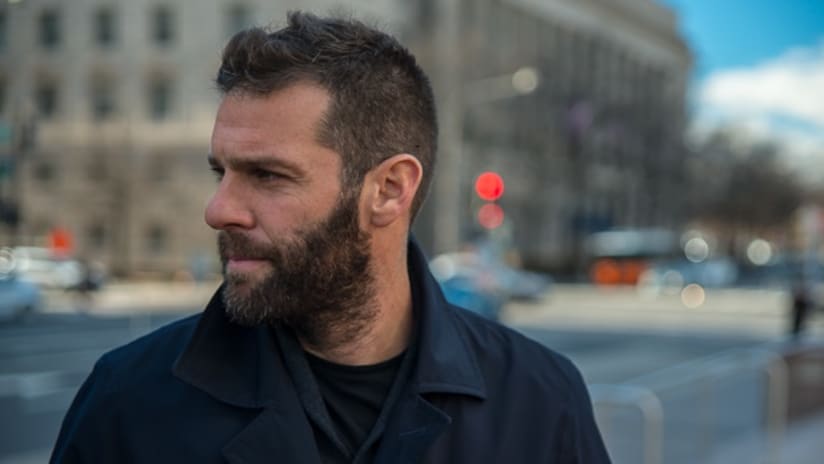WASHINGTON—Ben Olsen’s subterranean office at RFK Stadium centers around a simple, contemporary desk adorned by little more than a laptop and a framed family photograph.
All around it, however, are artifacts of the past.
Soccer souvenirs adorn the walls, with more stacked in one corner, waiting to be hung. The eye is drawn to a framed 1962-vintage D.C. Yellow Pages cover featuring the then-brand-new RFK – a gift from a fan – and a vibrantly impressionistic painting of him early in his professional playing career, a work of his since-departed grandfather, who painted similar portraits of all his grandchildren. The room’s feature items: Large, rustic signs from long-gone Pennsylvania businesses, one an agricultural company, the other advertising now-obscure meat products.
It will surprise few D.C. United fans that their head coach and club icon proudly hails from a “family of junkers,” as he likes to put it. His older brother Jeremy runs a hip antiques shop in Philadelphia, and will be among a large contingent of family and friends in attendance on Saturday when Olsen, a native of Middletown, Pennsylvania, leads the Black-and-Red into Talen Energy Stadium to face their I-95 neighbors, the Philadelphia Union (3:30 pm ET | TV & streaming info).
“I go there quite a bit to visit, it’s one of my favorite cities,” Olsen says. “I always have a good 30, 40 people going to those games, and it’s nice to see old coaches and friends. When I go back there, it’s always a reunion.”
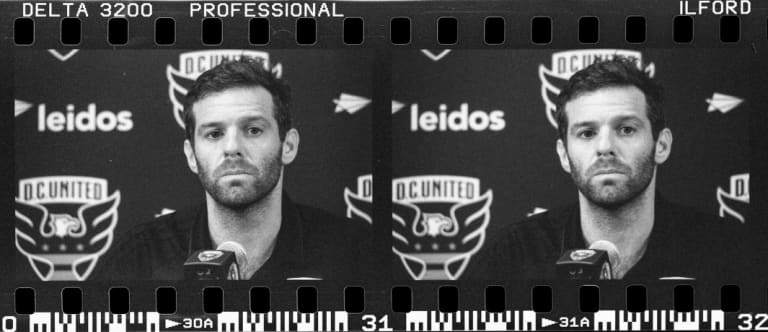
Ben Olsen: An old-school coach entering a new era | Pablo Maurer
A United lifer, Olsen has spent most of the last two decades in ancient RFK, though he’ll be moving his keepsakes to much newer digs soon enough. 2018 heralds a new era for United, with a downtown stadium set to debut in July, a new training facility and USL venue slated to open next year, reports of new owner/investors and myriad transformative changes unfolding from those long-awaited developments.
“There’s a lot of really, really good people working extremely hard who care about this club in a deep way, and also believe that there’s brighter days ahead,” Olsen told MLSsoccer.com in a long, in-depth conversation this week. “With that comes new expectations. The people that have been here a long time will welcome that – when things do change and we get a new stadium and the infrastructure’s a little bit more sound, and we’re able to focus not on making the playoffs, but winning an MLS Cup. That hasn’t necessarily been the priority over the past four, five years.
“There’s going to be a push here … the stadium’s coming, that’s the first domino. Things will move, and they’ll move pretty quickly after that.”
Forced to make the most of limited resources while stuck at RFK, in recent years D.C.’s owners asked Olsen and general manager Dave Kasper to keep the team competitive in “Moneyball” fashion, picking up bargains and castoffs and playing direct soccer when needed. The pragmatic approach worked reasonably well, the Black-and-Red qualifying for the MLS Cup Playoffs in four of his seven full seasons in charge, albeit sandwiched around a couple of basement finishes.
“I don’t know if it’s a compliment, I don’t know if it’s a dig. It’s probably a little bit of everything, right?” says Olsen when asked about the model, dubbed “Bennyball” by fans. “I don’t disagree with you as far as what the last five years have looked like – a little bit of trying to punch above our weight, whether it’s the resources, whether it’s how can we effectively win a ballgame over aesthetics.
“But it is what it is. I come to work every week and I’m doing everything I can to help this team win and I give everything I have for this club and I can sleep at night with that. Whatever people want to think about me or the club, that’s up to them, man.”

Olsen during the "Bennyball" era | Pablo Maurer
While United waited and worked and scrimped for a new home of their own, the league they helped build has grown ferociously, into something that scarcely resembles the one D.C. once lorded over. Now, after years of being MLS’s poor relations, the four-time MLS Cup champs finally aim to rejoin the league’s elite, and with a vengeance.
“There is going to be an evolution to our team, and I think you can see that with some of the players that we’re now scouting and we’re bringing in to this team,” Olsen says. “The league is moving very quickly, and the way we were doing things for a while is not cutting it. That’s the reality. For four or five years, you could punch above your weight and you could grind out more results than you can now. There’s just too much quality. So we now have to evolve with the league. We’re under no illusions with that. There’s just too much money coming in and there’s too much quality with the opponents.
“The timing is right for us now to make that push.”
A founding MLS franchise and the only one to have spent their entire existence at one home venue, D.C. are a tradition-rich organization about to enter thrilling, but uncharted territory. And Olsen, now the second-longest-tenured coach in the league, is one of the only faces left from the old days, carrying the torch of history in a job where permanence is exceedingly rare.
“That’s life. The evolution of the club, and the game, and MLS – it’s all happening at such a rapid pace,” he says. “But the history of this club is not lost on me and I do what I can to keep it alive in this building, with these players – walk around. Old dusty photos of Marco [Etcheverry] and John [Harkes] and Richie [Williams] and Eddie [Pope] – we pop them up all over. it’s important for these guys to see that history. I got two old signs in there, I keep the memorabilia.
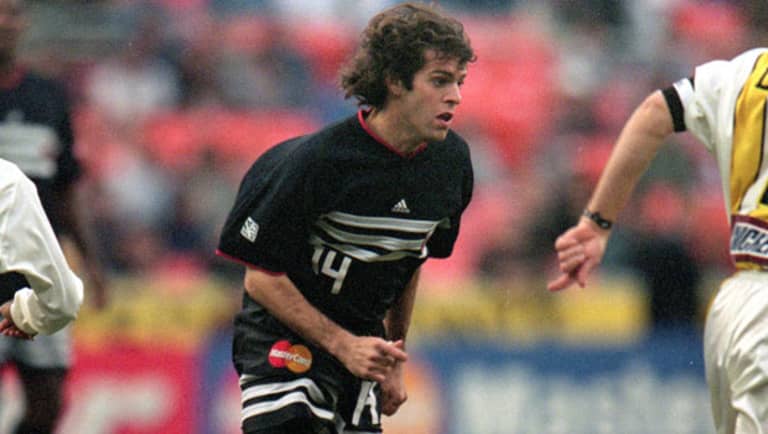
Olsen during his early years with D.C. | Getty Images
“Marco and Jaime [Moreno] were here today. Players drop by all the time. I don’t worry about us losing touch with our fans or the people that have worked in this building. That goes from staff, coaches, players – not a lot of guys who have been through this building, or worked at this club and have gone to other places, have a lot of bad things to say about the culture here and how we go about things. You can ask them.”
Olsen, who turns 41 next month, has had a front-row seat on MLS’s ascension from a 10-team circuit straining for survival to a large and growing powerhouse pulsing with more and more investment, stardom and ambition all the time. He knows how difficult it will be for his club to regain its past heights – even if D.C. go on a summer shopping spree, with the likes of Mario Balotelli and Carlos Tevez recently linked to the club.
“It’s infrastructure – and money. Don’t overthink it,” he says dryly. “I will say the level of coaching is far superior than it was a decade ago. It’s a really interesting league to coach in because of the variety of styles that you face on a weekly basis. There’s a lot of leagues out there that are a little bit more homogenous. Now, the preparation you have to do leading up to a game each week, you have to be adaptive and you have to push yourself tactically as a staff to get results in this league.”
Olsen himself had to learn his trade on the job, and took his share of slings and arrows for it. Asked to take the reins on an interim basis after the firing of Curt Onalfo halfway through D.C.’s disastrous 2010 campaign, he eventually got the permanent gig and United kept faith in him despite many peaks and valleys since. Even today, he considers himself far from a finished product.
“I had no business being a coach when I started, so the bar was set pretty low,” Olsen says. “I’ve understood, as I get older, who I need to surround myself with. What will make me whole as a coach? Because I’m not a complete coach, there’s areas I need help in … You make yourself whole through people around you who are hard-working, have a growth mindset and that seems to be the case [here]. I’ve been more removed from players and trainings as I’ve evolved as well.
“Players nowadays, they want answers. They want a clear picture of how are we going to play, how are we going to defend, how are we going to attack, what do we look like in transition, on the defensive end and the offensive end. And they want clear training sessions, fine-tuning all those elements leading into the game. They want more.
“But one of my strengths is managing players and emotions and treating people like human beings,” he says. “It’s a fun part of the job, it’s an exhausting part of the job. That always takes the most energy out of me – managing players and managing a team and the emotional roller coaster of a season. I’ve learned to pace myself better than as a younger coach, where I would run around with a fire extinguisher and try to put every fire out that I could, try to solve all the problems in the moment.”
D.C. assistant and former academy director Nolan Sheldon runs most of United’s training sessions, while Kasper oversees most of the recruitment process for new signings and acquisitions. Though he readily acknowledges the limitations of the past, Olsen does bristle at one line of criticism occasionally sent his way: That he and his club don’t value or trust young talent, particularly Homegrown players.
“Who could ever say I don’t trust young players? That, I don’t understand,” he said, reeling off a long list of D.C. academy products who rose to the first team – names like Bill Hamid, Andy Najar, Ethan White, Jalen Robinson, Ian Harkes, Chris Durkin. “My team right now is young as can be. I think maybe because we’d bring in some older guys that were a touch past it to kind of get us to where we wanted to be – and that was in the playoffs – to punch above our weight and survive for a couple years. That was our model.
“But as far as playing young players – I got two guys in Europe [Hamid and Najar], that are potentially going to be in the [UEFA] Champions League, that I played when they were 19 years old,” he added. By D.C.'s calculations, no team in MLS has given more playing time to Homegrowns since the designation was created in 2008. “And who here in MLS, besides New York and Dallas, who else is doing a great job with their Homegrowns? Who else has done better than us? … I don’t understand why we’re getting so much [stuff] for the academy. I think it should be the opposite – ‘You guys are working miracles.’”
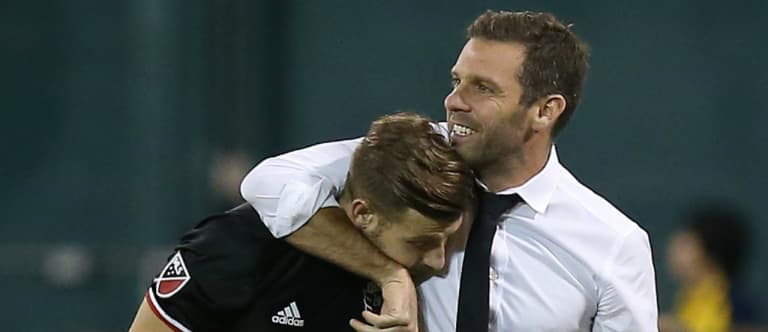
Olsen with D.C. winger Paul Arriola | USA Today Sports Images
Olsen’s love for his club is clear, but it’s taken a toll of sorts, too. Known for his wisecracks and ready smiles as a player, he cut a more serious, at times even somber figure as he led D.C. through the lean years, including a dead-last finish in 2017.
“Over the last year, there hasn’t been a lot of joy to the job,” he admits. “A huge part of the joy to me is developing players, in particular pushing young guys to get to where they need to be, and winning. And we haven’t won a lot over the last year-and-a-half. That’s the reality. And with that comes baggage, and heaviness. Because ultimately I am an extreme competitor.
“You get graded every weekend, and if that grade is a loss, consistently, it can weigh.”
And the changes swirling around United, as welcome as they are, do cut in multiple directions. Olsen is a longtime District of Columbia resident who’s advocated for D.C. statehood and is raising his three children in the heart of the city. A fleeting grimace flashes across his face when asked if he’ll move out to the exurbs when the club’s new training facility opens in Leesburg, Virginia next year.
“I am a city guy,” he says. “Listen, when you’re in this job, you live week-to-week. We’ll deal with that stuff if and when I have to make that decision. I do think – I go back to what a great time to be a part of this club this is, with the stadium, the new training facility. It’s no secret there’s been some talk about new ownership or added owners to Jason’s group. So I think it’s a really, really exciting time to be a part of the club.”
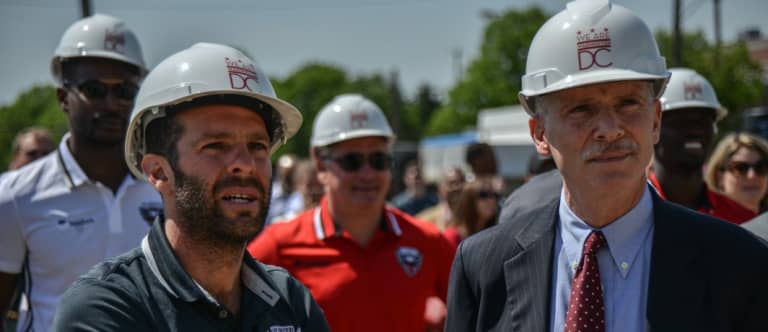
Olsen with D.C. City Council chair Phil Mendelson at an Audi Field groundbreaking event | Pablo Maurer
Olsen’s current coaching challenge may be his biggest one yet. With Audi Field not opening until July 14, United are in the midst of a lengthy span of season-opening road trips, their only “home” dates two temporary-site games at the Maryland SoccerPlex and Navy-Marine Corps Memorial Stadium. Though they plan to vault up the standings with a heavy run of home games in the season’s second half, the Black-and-Red have to keep their heads above water in the meantime.
“It’s hard to appreciate what’s coming in the future in a job that is so present – you’re just constantly in the now in the coaching business,” says Olsen, who will lead his players on a tour of under-construction Audi Field next week. “It’s a grind. We’re away, we’re away, even our home games are away. So it’s important to get them excited about what’s coming here not only this year but from a club standpoint, where this club’s going. It’s certainly time, due time.”
So one last stretch before D.C. reach their brave new world. And then their throwback coach will finally get to shoot for the stars.
“I like our group this year. I really like our group,” says Olsen, whose overhauled side have taken five points from their first six games. “I think we will add some real pieces to this team, maybe in the short-term but more likely in the summer, to bolster it and take what I think is a good young core to the next level. The timing of that will be hopefully the right time to open up the new stadium.”

